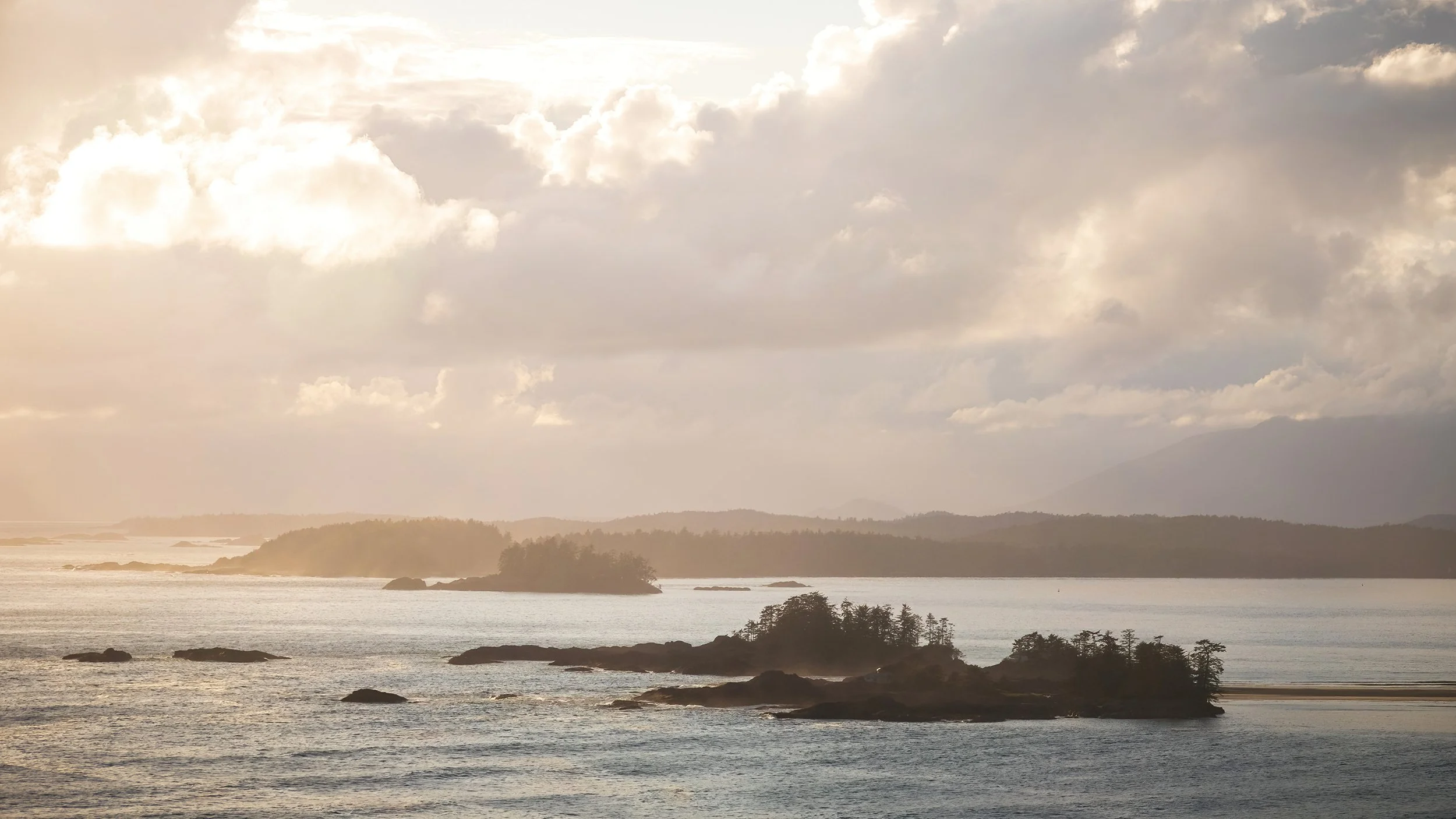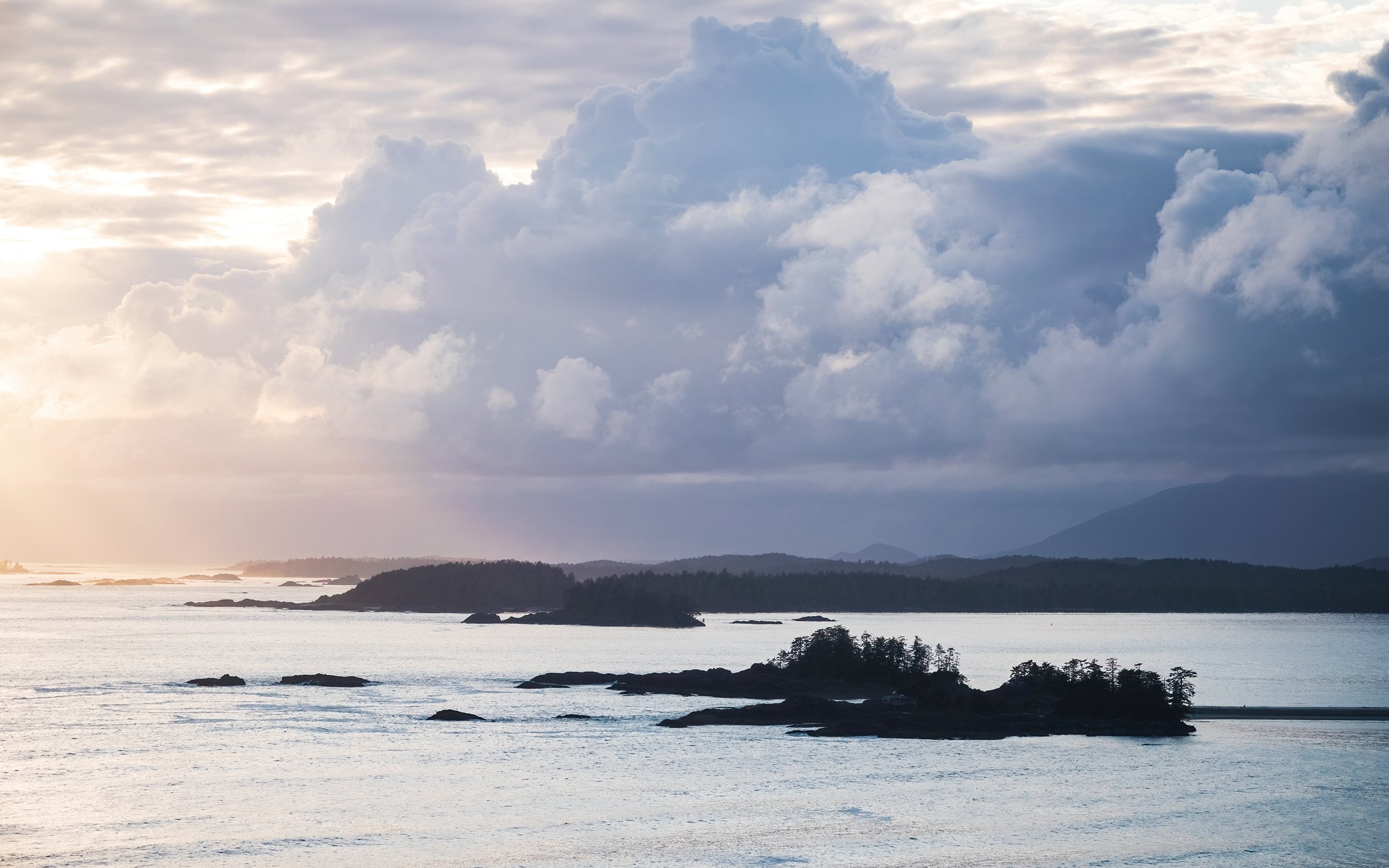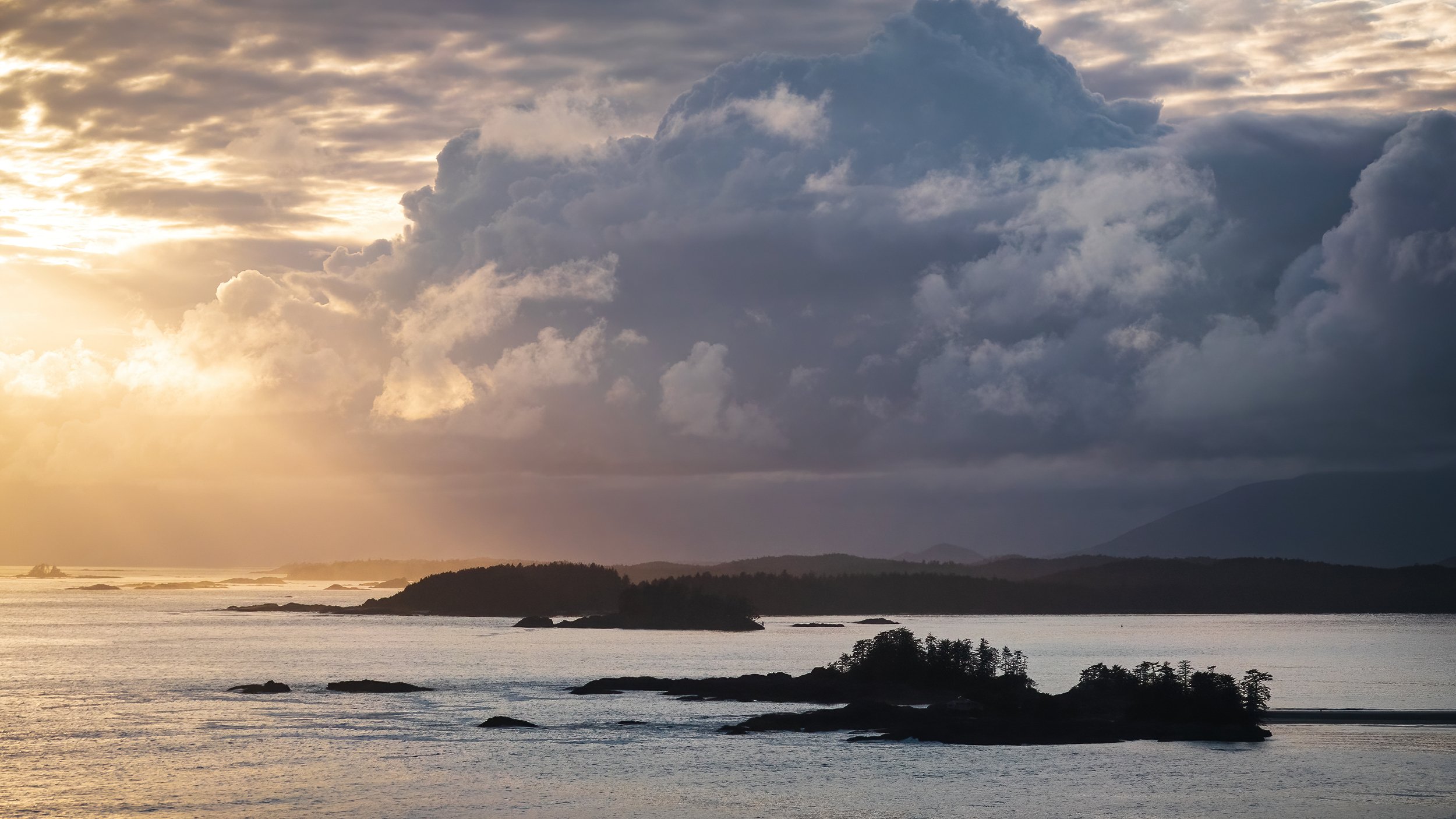“I loved every bit of it — no boundaries, no beginnings, no end, one continual shove of growing — edge of land meeting edge of water, with just a ribbon of sand between. Sometimes the ribbon was smooth, sometimes fussed with foam. Trouble was only on the edges; both sea and forests in their depths were calm and still. Virgin soil, clean sea, pure air, vastness by day, still deeper vastness in dark when beginnings and endings join.”
— Emily Carr (1871-1945)
Growing Pains: An Autobiography
I wake up after a night of restful, quiet sleep at the Hotel Zed Tofino. It’s a relatively new joint - built in 2020 and opened (post-pandemic) only a few years ago - new enough that it wasn’t on my radar during original trip planning between 2019 and 2022. The whole building has fresh decor and a cool, retro-70’s vibe. After a relaxing rain-shower and breakfast, I head out in the early morning. Again, I’ve intentionally slept in past sunrise, as the rain has only finally let up in the past hour. The rest of the day, though, promises, to be clear and sunny until nightfall - a welcome change after several days of wild and moody weather. In stark contrast to the previous day, drive time will be minimal; most of the day will be spent on-foot exploring the trails of the Pacific Rim National Park Reserve and the environs of the Esowista Peninsula, including the surf-town of Tofino. This fragment of the northwest coast - a jumble of sounds and islands, forests and mountains - is an ecologically and culturally significant place. The Clayoquot Sound was the focus of the “War in the Woods” in the early 1990s, a series of blockades that saw indigenous and Anglo-Canadian residents of the area joining forces to prevent logging on nearby Meares Island. To this day, the UNESCO-recognized Clayoquot Sound Biosphere Reserve protects nearly half a million acres, including ecosystems as varied as temperate rainforests, lakes and estuaries, and alpine peaks. It is a beautiful place to spend time on the ground, photographing the region’s diverse flora and fauna in the context of their living landscape.
My first stop of the morning is the boat launch at the end of Grice Bay Road, which faces out on one of the winding inlets between the forests, and features a stunning panoramic view over the mudflats east of the Esowista Peninsula. It’s a serene morning: clouds rolling across the sound and obscuring the view of distant peaks beyond Indian Island, mist rising from the trees on neigboring islands, a squad of fishing boats quietly loading up and setting off across the water. I make use of the long lens of my camera, zooming in to capture distant features in the landscape. I’m spending part of the morning scouting for potential sunrise locations for the fourth and final full day of my trip, in case the weather tomorrow will allow for golden light (spoiler alert: it will not). Grice Bay, for the moment, is one of my top candidates. I next backtrack to Radar Hill, where a short paved walk leads to a hilltop vista overlooking the entire peninsula, from the open Pacific Ocean to the west, to the mountains and sounds to the north and east.
Zigzagging my way back across the peninsula, I next take a long walk at Long Beach, a massive, 10-mile stretch of sand that spans the length of the Pacific Rim National Park Reserve, and is the very heart and soul of the park. Despite the early hour, there are a few surfers catching waves out beyond Incinerator Rock; I sneak some shots of them as they walk back up the beach, in order to convey some human scale in this enormous place. Turning south down the beach, I set off, walking over a mile across the sands. The coast seems to stretch to infinity, the distant forests always receding no matter how far I walk; in the gloaming and the half-light of the shrouded sun, the boundary between sea and sky seems blurred to my eyes and to the camera lens. I walk along slowly, following the wrack line, admiring the tangles of driftwood and kelp - lost in my thoughts, once again. It occurs to me that, here in the park, with precious few signs of civilization, this incredible beach must appear quite similar to how it did a century ago, or a few centuries ago. A truly timeless place - the wild, western edge of the country. I find myself wondering how it must have felt to be a Anglo pioneer here, a world away from the aristocratic trappings of Victoria, long before the asphalt highway and the logging roads, the beach resorts and tourist towns. In a land inhabited richly by the First Nations, the sea wolves and the black bears, the orcas and the salmon. I find myself full of gratitude, that places like this can still exist, and hopefully will for some time.
Further to the south, I park at a trailhead within the national park that leads to two stands of old-growth cedar rainforest on either side of the highway. Although the environment does not approach the magic of Eden Grove, these forest groves are nevertheless quite dense and lovely. I take photos from throughout my walk - including a selfie along the boardwalk - before returning to my car and driving back to Tofino. On the way into town, I stop a second time at Grice Bay to see if the clouds have lifted at all across the water. The mountains remain invisible, but the inlet appears strikingly different at low tide. I take a few shots of the braiding estuary channels across the mudflats, before moving north into town.
Tofino is a surf town through and through. There is something magical about the place, surrounded as it is by multiple bodies of water, across which sit mountainous island peaks that peer down at you from beyond the clouds. It can get pretty crowded in the high months, but I manage to find easy parking in a pay-lot just off the main street, and set off exploring on foot. Things are quieter this week than they will be for the rest of the season, as I am visiting one week after the Victoria Day holiday week in Canada. Several shops and restaurants in town are closed today - giving the staff a midweek break before the frenetic activity of the summer months. I wander the waterfront, photographing the distant islands, the boats in the marina, the floathouses in the inlet, all the while looking for a bite to eat. Eventually, after dodging around town and into both a grocery store and a bookstore in rapid succession, I settle on grabbing a patio seat at Shed and ordering a burger and fries. After lunch and a bit more wandering back along the road for different views out onto Tofino Inlet, I return to the car and head back to the hotel for an afternoon rest break. Along the way out of the town, we are halted for road construction - preparations for the summer, no doubt. Everywhere along the roadside, rhododendrons and other summer flowers are in full bloom.
In the late afternoon, after a good bit of relaxing in the hotel room and a brief nap, I head back out to Chesterman Beach, just a few minutes away. This L-shaped stretch of sand covers one elbow of the Esowista Peninsula, connected at low tide by a tombolo to nearby Frank Island. I walk the expanse of sand from South Chesterman Beach to the tip of the sandspit - an enjoyable walk with lovely views of the distant mountains rising up over Tofino and its inlet. Along the way, I run into other beachgoers: a raven picking apart a mussel, a flock of sandpipers scurrying between intertidal channels, and a friendly goldendoodle dragging its leash behind it, who brings me a frisbee to throw. I look around for an owner, but they are nowhere to seen; the frisbee is thrown. Along my way up the beach, I photograph the action of the waves crashing on nearby Pettinger Point, and beyond them, the forested knoll overlooking Cox Bay, where I will be spending the sunset golden hour. The beach is expansive and beautiful. I reach the rocks below Frank Island before turning around and making my way (slowly, gradually) back toward the car.




My final stop of the day is only a few minutes away down the road: a walk down Sakurai Lane, along Cox Bay Beach, ultimately climbing to a hilltop overlook of the bay and the entire peninsula. It’s 7 PM now - I’ve budgeted plenty of time until the 9 PM sunset, as it seems almost a certainty that the scramble up and down the hill will be quite an adventure. Before getting there, I photograph the sidelight falling between the trees along my walk (a easy gravel stroll shared only by a few surfers returning from the beach), and the driftwood and tidal channels on the beach itself. Reaching the foot of the hill, I clamber up a stone ledge and begin a steep climb up the hill.
Maybe it’s just me, or maybe it’s the recent rain, but while this trail is a known quantity and a well-visited sunset spot, I would classify it as, at best, “barely better than a bushwhack,” and, to be frank, “the muddiest thing I have ever done.” In some places, I cross through shin-deep mud to find my way through the tree roots and up the mountain. The way up is not so bad, as there are plenty of roots and branches to grab ahold of and pull oneself up. It’s the way down that I fear; even though I am carrying a headlamp, I mentally make a note to myself to get back down to the beach before the post-sunset twilight gets too dark. One wrong move could lead to nasty slip and fall down the slick, muddy slope - messy, if not injurious. Secondly, I make a mental note that this trip will be the final hurrah for my hiking boots, which have accompanied me since our final year in Baltimore, and gone with me to places as varied as the Mid-Atlantic, the Adirondacks, the desert Southwest (three times), Oregon (recently), and throughout New England on multiple backpacking or foliage trips. A cheap pair from an outlet store, they sprang a leak almost immediately when I first began to wear them in 2019. That I’ve worn them for this many years after must be a reflection of either my laziness or my cheapskate tendencies - unflattering either way.
The scramble, thankfully, is not a long one. With socks damp yet again and each boot looking fully like its own chocolate ganache cake, I arrive at the top (sort of) of the hill, which offers expansive views over the windblown pines, to an breathtaking vista that covers the Pacific Ocean, Chesterman Beach and Frank Island in the distance, the waves crashing upon Cox Bay, the distant islands in Tofino Inlet, all rimmed by stunning mountains rising above the forest. After catching my breath, I take a moment to explore the hilltop, which involves some sketchy bushwhacking to reach a true summit viewpoint that faces east and south (perhaps a lovely sunrise location, but too adventurous for my taste, in the wee hours before morning). After confirming I am where I thought I would be, I move back to the northwest-facing slope. From this viewpoint (a false summit of sorts), there is not much room to maneuver, so I set up my tripod and patiently wait. Two other hikers and another photographer (carrying medium-format gear, of all things) reach the top shortly after me; we trade some disbelief about the bushwhack before they move on, returning back down to a lower viewpoint out of sight from me. I am alone up top for the next hour, watching the light gradually change and getting eaten intermittently by some sort of biting fly (the bites don’t itch immediately like mosquito bites do for me, but the next few days prove that my skin is just as horrifically reactive to these as they are to any other insect bite; I return to work a few days later with hilariously large welts on my face and neck). For the moment, I am too caught up by the landscape to care about anything else. I take a mix of long shots and panoramas, using my circular polarizer to bring out the best of the sunset light. We never quite get the fiery skies of a genuine, low-horizon sunset (the sun dips into a marine layer half an hour before setting, an oh-so-common occurrence around these parts, as I realized in Oregon), but the photos below are still quite pretty and hopefully capture the evening’s mood.
As the sun sinks into a bank of clouds, I resolve not to stick around until dark, which turns out to be a wise decision. I get a headstart down the mountain; there is a decent group gathered on the ledge below mine, but I hardly see anyone once I descend into the trees and begin making my way down the muddy slope. After what seems like an eternity (in reality, just 15 minutes or so of carefully lowering myself down some very slick surfaces), I re-emerge onto the beach and begin my walk back to the car. At Sakurai Lane, I turn around and take a final shot of surfers stepping out of the waves and preparing to leave for the night. All in a fine day’s work (and play).






























































